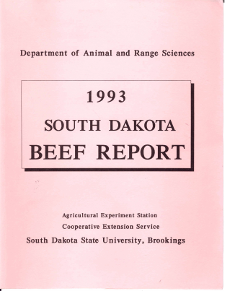Document Type
Report
Report Number
93-19
Publication Date
1993
Keywords
feedlot profitability, retained ownership, value based marketing, consumer demand
Summary
Data collected from 759 steer calves that were consigned to the South Dakota Retained Ownership Demonstration were utilized to examine the effect of slaughter cattle marketing methods on production signals sent to beef producers. Marketing systems examined included basing price on live weight (LW), dressed weight (DW), grade and dressed weight (G and Y), or Excel Corporation's proposed muscle scoring system (MS). Profitability per head averaged $6.64, $23.54, $26.00, and $27.09 for the LW, DW, G and Y, and MS marketing systems, respectively. For the LW pricing system, average daily gain, cost of gain, initial feedlot weight, and days fed accounted for 86.6% of the variation in profitability. For the DW pricing system, average daily gain, dressing percentage, cost of gain, initial feedlot weight, and days fed accounted for 92.9% of the variation in profitability. Average daily gain, dressing percentage, quality grade, cost of gain, and days fed accounted for 83.1% of the variation in profit for the G and Y marketing system. Average daily gain, dressing percentage, cost of gain, days fed, carcass fatness, quality grade, and rib eye area explained 75.6% of the variation in profitability for the MS pricing system. Only the MS pricing system rewarded production of muscle and penalized the production of carcass fat. Current fed cattle pricing systems used in the industry fail to transfer consumer demand for lean beef to beef producers.
Number of Pages
9
Format
application/pdf
Language
en
Publisher
South Dakota State University
Rights
Copyright © 1993 South Dakota State University.
Recommended Citation
Wagner, J. J. and Feuz, D. M., "Effect of Slaughter Cattle Martketing Method on the Production Signals Sent to Beef Producers" (1993). South Dakota Beef Report, 1993. 20.
https://openprairie.sdstate.edu/sd_beefreport_1993/20

